Welcome to yet another article where I reminisce about old things, dear readers. This time, it’s a German action-RPG series, Gothic, by Piranha Bytes. It still has a following in Germany, after all this time, or so I’ve heard. It certainly has a strong place in the collective memory of Polish gamers – as well as others in Eastern Europe. Why did it stick in our memory so persistently? I’ll try to dissect it. For better or worse, those games are quite special.
To start with, I’m not sure why they’ve got the name they do. They have nothing to do with Gothic art, architecture or literature. Perhaps it was a working title when the game’s concept was much different? In the end, the series became fairly typical, if dark, fantasy…at a first glance. But there’s more to it than that.
Gothic 1
The series begins with our protagonist thrown into prison. Or rather, a penal colony. The game’s intro paints a very simple picture: a generic fantasy kingdom fights against orcs, which requires a great quantity of ore to make weapons and armor. The king mines it using prisoners in the penal colony of Khorinis. To prevent escapes, he has his magicians create a magic barrier around them. However it was supposed to work, it didn’t. The barrier grew too large, capturing the mages as well, so the prisoners used the confusion to stage a riot and take over.
The king needed his ore, so he negotiated. He would trade with the prisoners, sending them goods in exchange for the metal. New prisoners would keep being sent there. The barrier allows inanimate objects to pass through back and forth, but living beings can only go in. No one ever gets out.
We meet our protagonist at the edge of the barrier, as a judge reads out his letter of condemnation. However, before he can get to our hero’s name, or the crimes he’d committed, a mage approaches. He gives the Nameless Hero a letter, saying that if he delivers it to the Magicians of Fire in the colony, they’ll reward him. He agrees, provided the judge shuts up. The mage agrees and has the soldiers toss him in. I’ll refer to the protagonist as Nameless Hero from now on, he never does get a chance to introduce himself.
The first thing the Nameless Hero sees in the colony is a fist. After he lands in the water beyond the barrier, a pack of bullies decides to haze him by means of punching. They leave after Diego arrives. An old and experienced convict, Diego explains to the Nameless Hero how the colony works, and gives him some directions. Then he leaves, telling the Hero to meet him in the Old Camp.
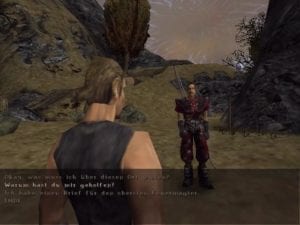
The Nameless Hero’s first goal is to deliver that letter, so he can claim the reward. But it’s not so easy. The Magicians of Fire reside on the upper level of the Old Camp, a settlement of convicts built around the guards’ former residence. Rank-and-file convicts have no entry there. Which sets up the game’s first challenge: join one of the three camps that arose in the colony.
The Old Camp is the oldest one, and the first one players will encounter, unless they deliberately go wandering. The people in charge are the “magnates”, which means the most powerful and influential convicts. They get the lion’s share of the goods from the outside. The most powerful among them is Gomez, and you’ll have to talk to him to join. But before you’re allowed to even see him, you need to get into the good graces of several prominent camp members, who are either Gomez’s guards or lower-ranking agents called shades.
The New Camp is a collection of people unruly even by the convicts’ standards. Although to be fair, plenty of people who end up in the colony are minor felons, people who couldn’t pay their taxes, or just unlucky folks who got on the wrong side of the law by accident.
Regardless, the New Camp has its own ore mine, but it doesn’t trade with the king. The Magicians of Water gather it to use in a ritual to blow up the barrier. Other inhabitants include mercenaries who protect the mages, a collection of scoundrels, and the dregs who mine ore and grow rice. In order to join the gang, you need to get on their boss’ good side, and there are a few options to do it. The New Camp members aren’t welcome in the Old Camp, but Magicians of Water use the scoundrels to run messages between them and the Magicians of Fire. You can convince the boss to give such a message to you.
Finally, the Swamp Camp is found in, well, a swamp on the edge of the barrier. Its inhabitants worship an entity they call the Sleeper, who will one day wake up and free them all. The power in the camp belongs to the Gurus, whose safety is ensured by temple guards. The novices, meanwhile, do the bulk of the work to keep the camp running. In order to join them, you need to become a novice. That requires the consent of at least four gurus. The problem is, outsiders can’t speak with them unless they expressly permit it, so you have to get creative.
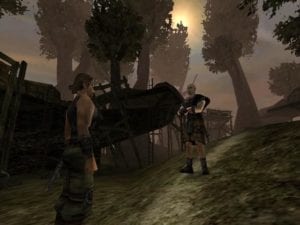
The first Gothic is one of those games where the beginning is by far the most memorable, and the purest expression of the game’s draw. You navigate the complex politics of the penal colony, trying to get on the powerful people’s good side. Those stronger than you can and will bully you or just straight-up oppress you. You’re very much a wet-behind-the-ears newcomer, in the social and physical sense. The game pulls no punches when it comes to difficulty, and it’s very possible to run into something or someone you have no hope of defeating. NPCs will usually beat you up and take some of your money, but animals and orcs will show you no such clemency. Unlike in most RPGs, where they’re training wheels for beginning adventurers, orcs in Gothic are tough and vicious fighters.
It’s hard to describe it in an article, but the atmosphere at the start of the game is intensely thick and immersive. I don’t use the word “immersion” lightly, but Gothic merits it. Several factors contribute to building it. The first is the difficulty that I’ve mentioned before, along with a technically-open world. You can theoretically go anywhere within the colony, but until you’re strong enough, you will likely die if you stray from the roads between camps. The content doesn’t scale with the player’s level, although new creatures may appear as they progress through the plot.
This creates an illusion of a world that’s much bigger than it actually is. The colony is, in fact, very small. But gating parts of it behind the Hero’s strength skilfully conceals its true size. The game generally tells you where to go, so you’re not as likely to wander off and die as it might sound.
The other factor that builds the immersion is a lot of work that went into ambient actions. The NPCs sit, walk, eat, drink, repair their huts, cook. Even though they perform them entirely at random, according to their scripts, it does create a remarkably believable illusion of life. Not just that, the Hero can perform those verysame actions. They’re context-sensitive, so you need to approach the right object, such as a chair, a loose plank in a wall, etc. It’s all entirely pointless, but immersive.
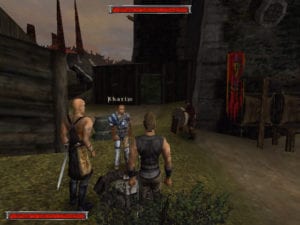
Adding to this is ambient dialogue, which is to say, NPCs talking among themselves. In most RPGs, it means you will hear the same dialogue over, and over, and over again. Like when running through Whiterun in Skyrim, and hearing the same riveting discussion about buying food. Or being told that I don’t go to the upper part of the town once. Even though I’m a thane. Or hearing the same two racist humans discuss the finer points of exterminating elves in the first Witcher.
Gothic does something completely different. When not otherwise busy, NPCs will pair together and talk. They do so by exchanging context-less bits of sentences. It won’t be long before you’ve heard them all, of course, the pool isn’t that big. But, once again, it creates an illusion. Especially in your first playthrough, it gives you the impression of catching bits and pieces of a conversation as you walk by or do something else.This might sound a little ridiculous, but somehow it works.
Finally, the immersion is built simply by the writing, dialogue, plot and gameplay. By making the Nameless Hero a weak rookie and surrounding him with people who are pretty rough around the edges at best, the game creates an atmosphere of being on the bottom of the totem pole in a harsh environment. You have to suck up to those in power and pick your battles to get ahead. You could also keep your head down and just mine the ore, but then we wouldn’t have a game.
Unfortunately, this atmosphere grows less thick as the game goes on. The Hero eventually becomes strong enough to challenge many of the tougher convicts and beasts. After you join a camp and deliver the letter, the previously branching plot merges together. No matter which camp you’re in, you will receive orders to help the Swamp Camp with their preparations for awakening the Sleeper. From that point onwards, Gothic gradually loses a little bit of what makes it unique.
What about the game’s technical side? Well, this is the less-good part. Gothic was a buggy mess when it came out, and it’s unlikely to get better on modern computers. The game’s engine is as rough and coarse as the colony and the people that inhabit it, but it doesn’t exactly add to the atmosphere.
Some bugs lead to hilarious exploits. For instance, when you fall off a great height, eventually the hero will assume a horizontal position and start flailing his arms; this signals that the fall will be fatal. However, if you press the button to sidestep mid-fall… the animation is cancelled and the hero falls to the ground safely. Even if he jumped from the highest ledge in the colony. The number of different things that don’t quite work would be too long, so I’ll just say the game could have used extra polish.
Now, the mechanics of character progression. They are dirt simple, but do some things uniquely. To start with, you gain experience and levels as usual. However, a level gets you only an increase in health and some skill points. To make any sort of use of those skill points, you must find a trainer. For some skills, it’s not hard. You can advance your basic attributes and combat skills easily enough. Other abilities are gated behind faction membership and status therein.
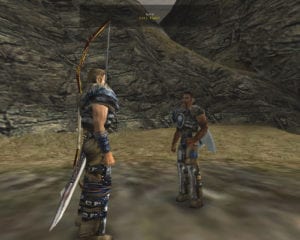
The basic attributes are strength, dexterity and mana, and the choice generally boils down to being a warrior or a mage, with Swamp Camp giving you the option to play a warrior who dabbles in magic. If you don’t follow the path of a mage, you’ll eventually master two-handed weapons and either bows or crossbows. But the requirement for trainers does effectively create classes in a system without them, in a more organic manner. You can theoretically learn anything, but you need to find someone who will teach it to you first.
Gothic 2 and Night of the Raven
Well, that’s enough about the first game. What about Gothic 2? It starts a few weeks after the first game. After triumphing over a major demon that had threatened everyone within the barrier, it turns that the whole temple fell apart on top of him. Only his magic armor kept him alive, until the necromancer Xardas (whom we had met in Gothic 1) brought him back. The ordeal weakened him considerably and he lost all his equipmen, thus explaining why he’s once again a wimp and not the high-and-mighty badass that he’d become.
Xardas brings our hero up to speed. The demon’s dying cry summoned many creatures of darkness, including dragons, which are now amassing in the mining valley. Our hero must go to the order of paladins and requisition a magic amulet known as the Eye of Innos.
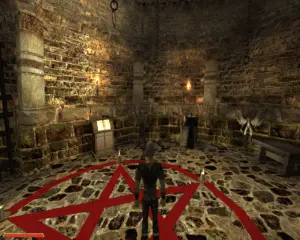
If it sounds trite, well, it is. That was a major disappointment to many, when Gothic 2 came out. The first game had a fairly original premise, even if it became a more typical fantasy RPG plot later on. Gothic 2 began with an army of darkness and a magic amulet we need to find to fight it. It’s not nearly as simple in practice, obviously, but it makes for a vastly different start.
This game lets us explore the land beyond the confines of the penal colony. Which turns out to have been on an island all along, to keep the available space manageable. To be fair, the penal colony did include a sea coast.
As we try to talk to the order of paladins and ask for the Eye, we run into a very similar problem. Namely, they don’t want to talk to a random nobody. In fact, even getting into the island’s major port city is going to be problematic. The war with orcs has everyone on edge, and now some jackass went and freed all the convicts from the colony. Even if you get through, entering the upper city is reserved for citizens. Even if you do become a citizen by apprenticing to a craft, the paladins still won’t talk to you without a good reason.
So, despite the much more typical setting, we engage in some very similar activities. We suck up to the important people, gather favors, and slowly become stronger. Our options are the city guard, the Magicians of Fire, or mercenaries. The last group features many people from the New Camp of the first game; this time, they serve a wealthy landowner who decided to rebel against the crown. Magicians of Water are absent until the expansion.
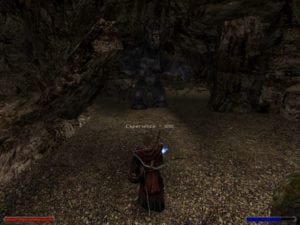
Gothic 2 is a good example of a sequel that improves on the original in many technical aspects, but loses something unique in the process. The choice of faction remains relevant, like I said, but the story itself is much more generic. The atmosphere is still there, as are all the tricks that make us think the game’s world is much bigger than it is. But it’s just not the same. Not to mention that the Hero is no longer the rookie he was. Even if all his skills are arbitrarily removed.
Character progression is also more varied, but the game’s variety comes at a price of deep imbalance. Properly utilizing the mechanics can remove many challenges. The biggest offenders are alchemy and crossbows. Alchemy lets you brew potions that permanently enhance your attributes, elevating them to great heights at a low cost in skill points. Crossbows deal lethal damage at range, while having minimal attribute requirements. Combining them is deadly.
The game’s expansion, Night of the Raven, strives to fix this, among other things. It adds a new storyline and an entirely new part of the island, but both run parallel to the original story. This…isn’t as seamless as one might hope. New NPCs and quests stick out rather visibly. You have to leave the original plot behind for a long time as you deal with the other potentially world-threatening thing. And then you get back to the old areas and never mention it again. Mind you, the vanilla areas need to be beefier to deal with your newfound strength and gear.
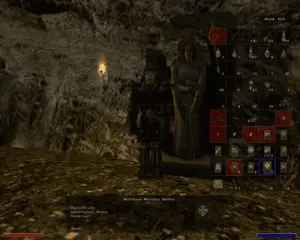
The expansion’s attempt at balance comes in the form of driving up skill point costs for higher attribute values. Once you advance past a certain point, every new point costs two skill points. Then three and four. It then adds the double whammy of racking up attribute requirements for items. This is brutal, and results in an even harsher early game experience than the game’s convention dictates. More importantly, it encourages using alchemy to crank up your attributes and scrounging up every possible way to raise them without spending skill points. The original game already rewarded meticulous planning; in the expansion, it’s almost a requirement if you don’t want to die horribly.
Gothic 2 might be more generic and have balance problems, but it was still a success among the game’s niche of fans. The greater variety of story and options, more land to explore and being able to revisit a much-altered former penal colony all appealed to players. The recurring NPCs were now a familiar staple that players had formed a bond with.
In the first game, we eventually run into four other convicts who help the Hero in some way; Diego, who greets us, is one. The others are Milten, a young fire magician, Gorn the mercenary and Lester the novice. The four turn out to share a friendship and alliance, which the Nameless Hero joins. Thus, he knows he can rely on them in the second game. It’s fairly well-developed.
You’ll notice that these are all men. And…well, the women really don’t get any sort of representation in those games, to put it bluntly. In the first game, the only women we ever see are servants of the most important people in the colony. We can’t talk to them, while every peon gets some generic dialogue otherwise. In the second game, there’s more of them, and we can interact with them, but they’re almost universally housewives. That’s progress I guess?
These games are old, but not that old, so there’s really no excuse. The third game is somewhat better in that it reaches the general industry standard for gender parity, but that isn’t exactly a ringing achievement.
Gothic 3 and Beyond
So, the third game. It’s controversial, and for once I think there’s a good reason. It begins where the second one ended, with our hero and his friends sailing to the mainland after defeating the undead dragon and abandoning the island of Khorinis to the rampaging orc horde.
After reaching the mainland, it turns out orcs had won, and the kingdom of Myrtana is now under their occupation. King Rhobar locked himself in his castle and had his mages create a magic barrier around it. On purpose, this time. Resistance against orcs continues, but some people decided to work with the occupiers instead.
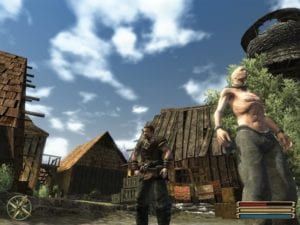
The orcs, I should mention, are not like the brutes who attacked us on sight in Khorinis. They look different and don’t act much different from your usual occupying army. They still look very similar to one another, and their culture seems fixated on honor in battle to the exclusion of anything else. But as one-note as they are, they’re now in the territory of the “honorable warrior race” archetype, rather than dumb and ugly cannon fodder. The sudden change is supposedly due to the orcs of Khorinis being a degenerate, demon-worshipping bloodline. Or something.
After we arrive and liberate a seaside village from orcs, we’re informed that Xardas (the necromancer from Gothic 1 and 2) nullified rune magic, which made paladins and mages easy pickings from orcs. He then disappeared. We have to look for him, and that’s basically all the direction we get.
Thus we run into the game’s first, biggest problem. The first two games had open worlds, but small ones that also had careful directions and natural barriers. The third Gothic is a more classical open world, in the vein of the Elder Scrolls games. And it’s clear that the writers couldn’t handle it.
There are many roads we can take from the starting location, but precious few directions. All we have to go on is that if we resolve the situation between orcs and rebels, someone might tell us where to find Xardas. So we have to defeat the orcs for the rebels, or vice versa. If we’d rather not get involved, we get nothing. And siding with one of the groups has us fight a whole settlement by ourselves, or maybe with some minor NPC help.
Trying to explore on our own can get us killed in short order, as there’s still no level scaling, but also no clear warnings about dangerous areas. And besides, the basic wolves and boars can do a perfectly good job murdering us in the starting area.
That’s right, the combat system is also pretty wonky, as are various other mechanics. The combat tries to be more elaborate, which results in animals stagger-locking and murdering us. Instead of the simple but crisp animations of the first games, everyone swings their weapons as if they weighed ten kilograms, telegraphing their attacks like crazy. Needless to say, two-handed weapons have it the worst.
Shields finally appear in the game, as does dual-wielding, which is as graceless as the other methods of combat. The character creation is more expanded, and skills aren’t otherwise locked behind factions anymore, although different trainers might require you to do something before they teach you. And then they cost exorbitant amounts of money to learn. It’s all really… sloppy. There’s no rhyme, reason or pacing to it. It wouldn’t be so bad on its own, I imagine, but combined with the plot, it contributes to the general feeling of aimlessness. What am I supposed to be doing? Where am I going? What do I want to learn?
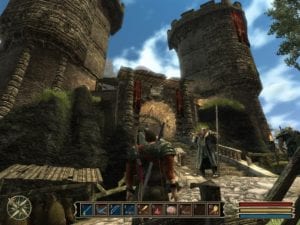
That really sums up my experience playing Gothic 3 for the first time. I wanted to like it, but I spent my time wandering, trying to keep up with the plot somehow and learn magic. The game insisted on throwing me in the midst of massive battles by myself, with maybe one NPC to help. The second time, I tried to play a warrior, but was worn down by the intensely inconsistent difficulty, the same sense of aimlessness and the poor combat animations.
There is, I should note, a fan-made patch for Gothic 3. It is sprawling in scope, rebalancing the gameplay and even adding content. Some say it makes for a great game. More power to them. I tried it, but still couldn’t stomach Gothic 3.
It’s sad, really. It could have been great. It has the making of a good game. There are a few small innovations I like. Health no longer automatically grows with level, for instance, so you don’t out-level challenges just by virtue of having too much health. All healing items restore a percentage of health or mana, so they’re as useful early on as they are later. In the previous two games, you started out healing with food and herbs, then moved to progressively stronger potions. The new attributes and skills might have been a good combination of the training model with more flexible growth, if they hadn’t been such a mess.
Unfortunately, the designers just couldn’t handle a more open world and story. It’s really a pretty good example of an open world gone wrong, where you have no idea where to go, what to do, or how to play. The first two games directed us in a way that felt natural and organic; the third one just throws us into the world.
That wasn’t the end of the franchise, but further titles were created by a different team. Forsaken Gods is an expansion that I haven’t played, but everyone consistently reviles it. Arcania: Gothic Tale continues where the third game left off, but does so by abandoning most everything that made the previous titles what they were. It’s linear, character progression resembles just about every other RPG; the protagonist is an incredibly typical Chosen One, living in a small village with his girlfriend until (spoiler alert) the village gets torched and the girlfriend dies. Riveting.
—
So that’s that, for the Gothic series. Through some issues with copyright, some of the people responsible for the original series moved on to create Risen, which is very similar to Gothic. In fact, the setting is basically the Gothic-verse with serial numbers filed off. The backstory is eerily similar to one of the three possible endings of Gothic 3. Piranha Bytes now owns the rights to the series again, but no one knows if they plan to do anything with them.
Well, I hope you enjoyed my thorough dissection of this old, but unique game series. For all their foibles and flaws, I think Gothic games offer a unique experience that no other game has replicated. For better or worse, they’re their own special thing. I encourage you to try them, even though it’s not going to be easy. But if you endure the obscurity, bugs and difficulty, you’ll find something valuable.

